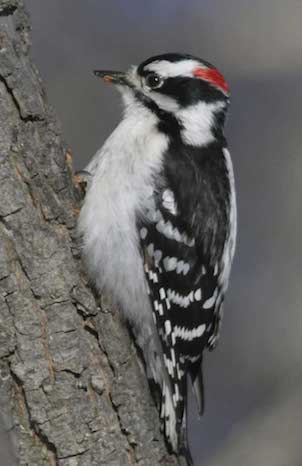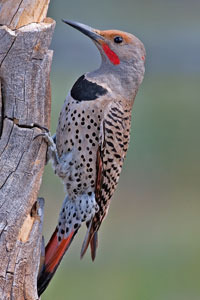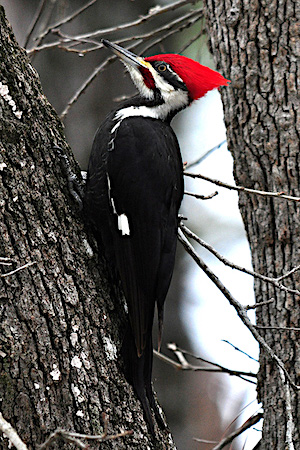Friend or Foe
At Home With Virginia Woodpeckers

Downy woodpecker
By Angela Sakran, former Fairfax Master Gardener
What lover of Virginia outdoors hasn’t stopped to peer into the trees, most times in vain, for a woodpecker you can only hear. When, however, you spot one hammering against a tree, it’s such a treat to see, and so worth the time you’ve paused to take in the world around you.
Did you know that seven different members of the woodpecker family call Virginia home year-round? They are resident species, and do not migrate during winter or for breeding purposes. These seven species are: the Red-Cockaded Woodpecker, the Downy Woodpecker, the Hairy Woodpecker, the Red-Headed Woodpecker, the Red-Bellied Woodpecker, the Pileated Woodpecker, and the Yellow-Shafted Northern Flicker Woodpecker. The Red-Cockaded Woodpecker is an endangered species on both the federal and state endangered species lists and lives only in several restricted areas in the southeastern part of Virginia. Fortunately for us woodpecker admirers, the remaining six live throughout the state of Virginia.
There is one other species of woodpecker that calls Virginia home for half the year called the Yellow-bellied Sapsucker. It breeds as far north as Canada, and re-locates to Virginia during winter months. Although it is common, because it is quiet and secretive, it is actually spotted less often. True to their name, this species of woodpecker eats tree sap and insects that are attracted to the sap. During the end of winter or early spring, when you would least expect it, the Yellow-Bellied Sapsucker may leave rows of identifiable holes on trees, known as sap wells. The holes are close together and may be viewed as running vertically or horizontally. Fortunately for most trees, the holes do not do lasting harm, as usually, enough bark is left so the tree isn’t severely damaged.

Northern flicker
Woodpeckers are pretty cool birds, as they are perfectly adapted to life in the trees. Their feet have two toes pointing forward and two pointing backwards. These toes are equipped with sharp, pointy claws that enable them to vertically scale tree trunks. Their toes also allow them to hang vertically by their feet, rather than perching like most birds. Additionally, they have very strong bills and neck muscles as well as a thick skull that protects the head as it hammers away. The way hammering woodpeckers perform is actually two different behaviors. One is drilling, and one is drumming. They drill to create holes for nesting or in search of food. Drilling happens in the fall, to prepare roosting holes for winter, and in the spring, to prepare for nesting. When a woodpecker drums, it does so to attract a mate or mark its territory. Drumming most commonly happens in spring before breeding begins.
In addition to being interesting, woodpeckers are also a wonderful addition to organic gardens. The reason? They are hunters, and they love insects! Their diet includes insects such as beetles, ants, caterpillars, bees, flies, mosquitoes, grubs and other insects found behind tree bark. They eat adults, larvae, pupae and eggs. However, they are not just carnivores; they also enjoy fruit, acorns, nuts, grains and seeds. Woodpeckers make their homes in mature forests, with trees that are dead or dying and/or decaying. Such trees are called ‘snags’. Whether initially caused by disease, insects, fire or weather, woodpeckers are attracted to the rotten, rough or broken bark, because it is here that insect infestations may be found. Although mostly tree feeders, you may also spot a woodpecker elsewhere. For example, you may see a Downy Woodpecker in a shrub, searching for fruit and insects. The Yellow-Shafted Northern Flicker is the only woodpecker specie that is also a ground feeder. So, if you see a woodpecker walking along your grass, it’s helping keep ants and other small insects at bay. Sometimes, you may see the Pileated and the Hairy Woodpeckers foraging for insects at the base of a tree or on a fallen limb.

Pileated woodpecker
Since woodpeckers help keep insect populations in check, there are several things you can do to encourage woodpeckers to stay interested and remain active around your yard and garden. The best attraction is, of course, food. They love suet, so putting out suet feeders is a way to welcome woodpeckers. Suet mixed with nuts, berries and fruit is even more enticing. Vertical seed feeders filled with black oil sunflower seeds, unsalted peanuts, and other oily nuts also attract woodpeckers. A little bit about feeders: I can personally vouch for the importance of a vertical feeder, as I have both a perch and a vertical feeder hanging in my backyard. The woodpeckers ignore the perch feeder, preferring only the vertical feeder. This is because woodpeckers are tree-clinging birds. Not knowing any better, I bought one of each and quickly noticed the woodpecker preference. Nesting boxes in safe spots are another way to invite woodpeckers to stay a while. However, the most natural and probably hospitable welcome for a woodpecker is the conscious decision to leave snags to beckon them. When cutting down trees, where possible (and with the guidance of an arborist), think about leaving trunks in place. This allows for the creation of a natural woodpecker habitat, making them feel right at home.
It is important to remember that, to a woodpecker, wooden siding or shingles on a house are just a large and peculiar tree. As a result, homes that typically suffer woodpecker damage tend to be brown or gray, or naturally stained cedar or redwood. If a woodpecker is drumming on your wooden siding, try hanging shiny, moving objects, such as long mylar streamers or pie plates, that will move with the wind. These provide effective scare tactics that discourage woodpeckers. Keep in mind, if more than one woodpecker visits your siding, there’s a good chance insects are present.
In short, the insect-rich diet of the woodpecker helps control the insect population around your yard and garden, and, of course, the additional perk to having these birds around is that they are beautiful, unique and just plain fun to watch. So, the next time you hear that familiar hammering sound, stop and take a look around. You may not be visually rewarded for your effort, but even if you can’t see this ecologically valuable bird, enjoy the sound of woodpecker life happening, and rest assured, a woodpecker is definitely a gardener’s friend.
Resources
• Pileated Woodpecker Overview, All About Birds, Cornell Lab of Ornithology
• Learn About Woodpeckers, Massachusetts Dept of Fisheries and Wildlife
• Hairy Woodpecker Identification, All About Birds, Cornell Lab of Ornithology
• Woodpeckers, Virginia Department of Game and Inland Fisheries
• Why Do Woodpeckers Like To Hammer On Houses? And What Can I Do About It?, Cornell Lab of Ornithology
• Woodpecker Situations & Solutions, Mass Audubon
• Downy Woodpecker Life History, All About Birds, Cornell Lab of Ornithology
…updated 2024